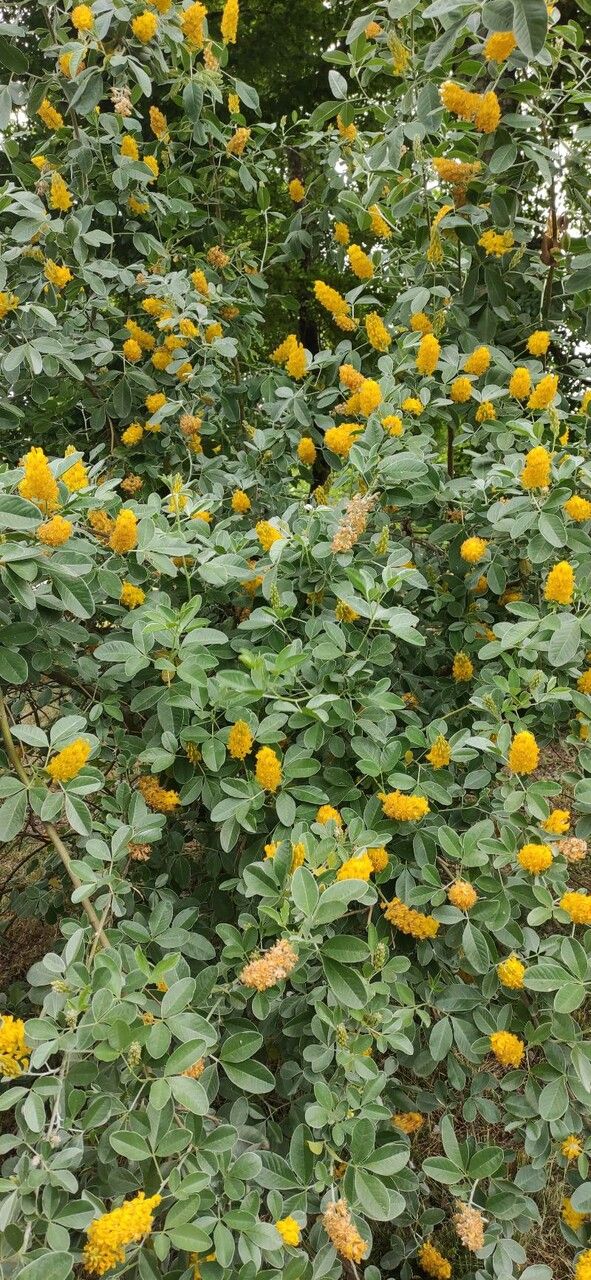Pineapple broom
argyrocytisus battandieri
Also known as: ["Pineapple broom","Silver broom"]
Overview
A deciduous shrub native to Morocco, known for its bright yellow, pineapple-scented flowers and silvery foliage.
Benefits & Perks
["fragrant flowers","aesthetic foliage","drought tolerant","seasonal color change"]
Botanical Classification
| Phylum: | Magnoliophyta |
| Class: | Magnoliopsida |
| Order: | Fabales |
| Family: | Fabaceae |
| Genus: | Argyrocytisus |
| Botanical Name: | Argyrocytisus battandieri |
Plant Characteristics
Basic Information
- Category: Shrubs
- Suitable Location: outdoor garden in a sunny, sheltered spot
- Suitable For:
- Is Weed: No
- Allergenicity: low
Environmental Needs
- Climate: {"temperatureRange":"5–35°C"}
- Hardiness: {"zones":"7–9"}
- Misting: rarely required, only if ambient humidity is very low
- Drainage: Fast-draining to prevent root rot.
- Soil Type: Well-draining, loamy soil with added organic matter.
Maintenance Level
- Maintenance Level: moderate
- Toughness Level: moderate
- Pruning Frequency: Annually after flowering; light pruning can be done as needed.
- Pruning Intensity: Moderate; remove up to one-third of old growth if needed.
Care Details
Ideal Sunlight Coverage:
Full sun (6–8 hours/day); tolerates partial shade but blooms best in direct light.
Sunlight Tolerance Tips:
Acclimate gradually to intense sun; protect from harsh afternoon sun in hot climates; ensure good air circulation.
Care Requirements
Care Difficulty
moderatemoderate
Sunlight
full sun
Avoid sudden light changes; use shade cloth if needed; rotate plant for even exposure.
Watering
every 7–10 days during active growth, reduce in winter
Water thoroughly but infrequently; ensure proper drainage; adjust based on season and weather.
Soil
well-drained, loamy soil with some sand
pH: Slightly acidic to neutral (pH 6.0–7.0).
Ensure good drainage; amend with organic matter; avoid waterlogged soil.
Temperature
Hardy to USDA zones 7–9; prefers 50–75°F (10–24°C); tolerates mild frosts.
Protect from frost; avoid extreme heat; adjust care seasonally.
Fertilizing
every 4–6 weeks during spring and summer
Dilute fertilizer to half strength; fertilize after watering; stop in fall.
Propagation
Methods
Softwood cuttings taken in late spring or early summer.
Step-by-Step Propagation Guide
- Take 4–6 inch cuttings.
- Remove lower leaves.
- Dip in hormone.
- Plant in medium.
- Keep moist.
Best Time: Late spring to early summer when new growth is firm but not woody.
Environment
Warm (65–75°F), high humidity, and bright indirect light.
Medium
Peat-based mix with perlite or sand for good drainage.
Hormone
Rooting hormone recommended for faster root development.
Timeline
Roots in 4–8 weeks; establish in new pot within 3–6 months.
Tools Needed
Pruners, rooting hormone, pots, misting spray bottle.
Quick Tips
Use healthy parent plant; keep consistently moist; provide bottom heat if possible.
Pruning & Repotting
Pruning Guide
Method
Cut back to healthy buds; thin crowded branches; shape as desired.
Pruning Plan
Prune to shape, encourage flowering, and remove dead/damaged growth.
Tools
Pruning shears, loppers, gloves.
Checklist
Sterilize tools; prune after flowering; remove dead wood; shape plant.
Repotting Guide
Best Season
Early spring before new growth begins.
Pot Size
Increase pot size by 2–3 inches in diameter.
Method
Remove plant gently; trim roots if needed; use fresh soil mix; ensure good drainage.
Suggestions
Repot every 2–3 years or when roots fill the pot; beneficial for growth and flowering.
Checklist
Choose new pot; prepare fresh soil; trim roots; repot carefully; water lightly.
Advanced Care Tips
Watering Mastery
Watering Checklist
Check soil moisture; water deeply; ensure drainage; adjust for season.
How to Apply Water Properly
Water at the base of the plant, ensuring moisture reaches the root zone; avoid wetting foliage; allow excess water to drain away.
Watering Schedule Tips
Water deeply when the top inch of soil is dry; reduce frequency in winter to prevent root rot.
Soil Improvement
Add perlite or sand for drainage; incorporate compost for fertility.
Temperature Stress Management
Signs of Temperature Issues
Leaf drop, wilting, or stunted growth in extreme heat or cold.
Cold Stress
Leaves may yellow or drop; growth slows; vulnerable to frost damage below 20°F (-6°C).
Solution: Mulch heavily in winter; protect from cold winds; move potted plants indoors if temperatures drop below freezing.
Hot Stress
Wilting, leaf scorch, or reduced flowering in prolonged heat above 90°F (32°C).
Solution: Provide afternoon shade; increase watering; use mulch to retain soil moisture.
Fertilizing Guide
Fertilizing Checklist
Use balanced fertilizer; dilute properly; apply during growing season; avoid winter.
Fertilizing Method
Use balanced liquid fertilizer every 4–6 weeks during growing season (spring/summer); avoid winter feeding.
Common Problems & Solutions
Toxicity Warning
Cats
Slightly ToxicCats may suffer mild gastrointestinal issues if they ingest the seeds or berries of Argyrocytisus battandieri. The plant is not highly toxic but can cause discomfort.
⚠️ Symptoms:
🌿 Toxic Parts:
⚡ Toxic If:
if eaten
Dogs
Slightly ToxicDogs may experience mild gastrointestinal upset if they consume the seeds or berries of Argyrocytisus battandieri. The toxicity is not severe but can lead to discomfort.
⚠️ Symptoms:
🌿 Toxic Parts:
⚡ Toxic If:
if eaten
Humans
Slightly ToxicThe seeds and berries of Argyrocytisus battandieri contain compounds that can cause mild gastrointestinal distress when ingested in significant quantities. The plant is not highly toxic but can cause discomfort.
⚠️ Symptoms:
🌿 Toxic Parts:
⚡ Toxic If:
if eaten
Frequently Asked Questions
Q: Does Argyrocytisus battandieri attract wildlife?
A: Yes, its fragrant flowers can attract pollinators such as bees.
Q: Is this plant suitable for coastal gardens?
A: Yes, it is moderately salt-tolerant and can thrive in coastal conditions.
Q: How often should it be watered?
A: Water moderately during the growing season, reducing frequency in winter.
Quick Reference
| Family: | Fabaceae |
| Care: | moderate |
| Light: | full sun |
| Water: | every 7–10 days during activ |
Get Expert Care Tips
Download the Plantious app for personalized care reminders and plant identification!
Google Play App Store






